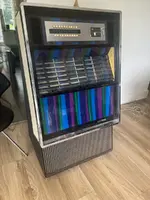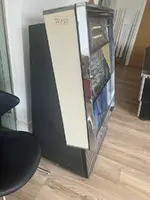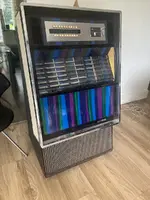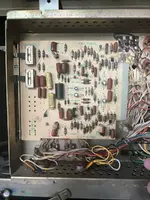Pinball info
You are using an out of date browser. It may not display this or other websites correctly.
You should upgrade or use an alternative browser.
You should upgrade or use an alternative browser.
In Progress Seeburg ESB100 Jukebox
- Thread starter AlanJ
- Start date
Quick initial look:
This one comes with the optional remote (wired) volume control and record rejection button.
The volume up and down switches control a motor in the main box, which turns the volume control potentiometer up or down!
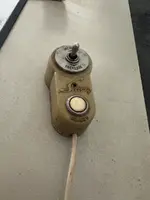
There is an extra (speaker?) wire coming out of the back.
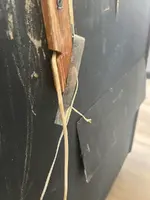
The rear cover plate is bent and hanging off.
It covers the selection Tormat, which is a complex and delicate component, so I’m hoping it hasn’t been messed with!
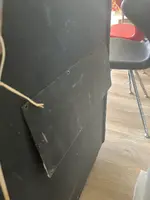
The main front door lifts up and should lock into place but the locking components are broken and part missing on one side and totally missing the other side. Why would anyone remove those……grrrr
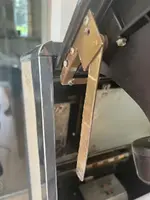
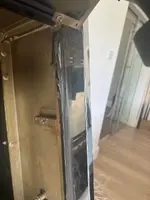
I’ll look for replacements but may have to make some or get some made.
Internal components all seem to be there
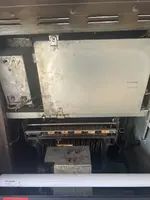
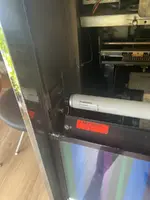
Crack in the insert artwork top left. Not major
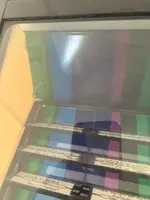
The chrome (over plastic) is bubbling and flaking.
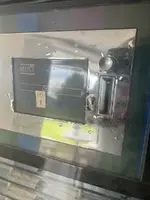
The main door won’t close and lock properly. It looks like it’s bent and falling apart - a large gap at the top, both sides
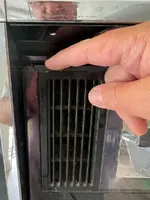
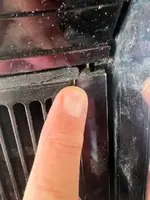
Plenty of cobwebs and dead .
.
My plan is to get it going first, then look at the cosmetics, once I know it’s worth the effort.
I’ll remove and inspect all the major electronic components and interconnects, (most plug in and are easy to remove). If all looks good I’ll power it up and see what happens.
Tomorrow I’m hosting a pinball comp, but may get a chance to do a bit more work on it.
This one comes with the optional remote (wired) volume control and record rejection button.
The volume up and down switches control a motor in the main box, which turns the volume control potentiometer up or down!

There is an extra (speaker?) wire coming out of the back.

The rear cover plate is bent and hanging off.
It covers the selection Tormat, which is a complex and delicate component, so I’m hoping it hasn’t been messed with!

The main front door lifts up and should lock into place but the locking components are broken and part missing on one side and totally missing the other side. Why would anyone remove those……grrrr


I’ll look for replacements but may have to make some or get some made.
Internal components all seem to be there


Crack in the insert artwork top left. Not major

The chrome (over plastic) is bubbling and flaking.

The main door won’t close and lock properly. It looks like it’s bent and falling apart - a large gap at the top, both sides


Plenty of cobwebs and dead
My plan is to get it going first, then look at the cosmetics, once I know it’s worth the effort.
I’ll remove and inspect all the major electronic components and interconnects, (most plug in and are easy to remove). If all looks good I’ll power it up and see what happens.
Tomorrow I’m hosting a pinball comp, but may get a chance to do a bit more work on it.
Attachments
I can’t safely work on this machine until the door is fixed, so first job is to mend the broken corner bracket
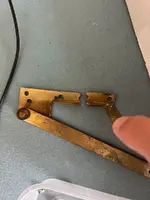
I prepped the metal to bare steel and held tight between two pieces of wood
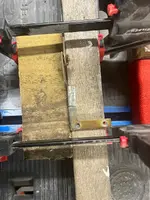
Added an extra metal piece and welded it
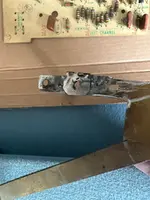
a bit of adjusting and removing extra metal to make it fit, it’s not pretty but the door is now firmly held together and closes properly
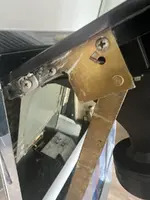
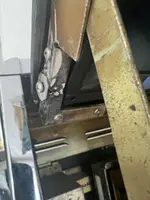
I now need to make a pair of retaining hinges to hold the door open when it’s lifted up.
Something like this:
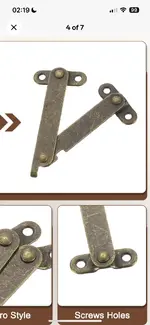
Nothing off the shelf is the right size, so I’ll make from bare fixing plates. Ordered from eBay. Should arrive later this week.

I prepped the metal to bare steel and held tight between two pieces of wood

Added an extra metal piece and welded it

a bit of adjusting and removing extra metal to make it fit, it’s not pretty but the door is now firmly held together and closes properly


I now need to make a pair of retaining hinges to hold the door open when it’s lifted up.
Something like this:

Nothing off the shelf is the right size, so I’ll make from bare fixing plates. Ordered from eBay. Should arrive later this week.
Now the door frame is mended, I can prop it up with a piece of wood to work on the components inside.

I powered on and the record player mechanism sprung into life and selected a record and started playing it. I rejected it using the wired remote and the next record was selected for playing. I rejected again and it continued to select the next record. It was playing "B" sides, then when it got to & played the first record in the rack it switched to going through all the "A" sides....., then back round to the "B" sides. There is obviously a fault with the read-out from the Tormat - I'll look into that later.
I also noticed I could select as many records as I wanted, - It appears maybe to have ben modded to free-play (but not sure). The selection relay is pulled in all the time, which isn't a great idea as the coil starts to get warm/hot after 5 minutes or so. (Back in the day, a customer would enter a coin and maybe take a few minutes making their selections, then the coil would de-energize, so it was designed to hold in for at least a few minutes, but not for hours on end). This is another thing I need to take a closer look at.
The good news was I got some sound out of the speakers. On closer inspection I noticed only the Right hand channel speakers were producing any sound. There is a top tweeter horn and a bass speaker in the bottom of the cabinet. I checked the wiring of the speakers to the amplifier and all is wired correctly. I swapped the left and right speaker wires and the sound switched to the other speakers (however I noticed the left tweeter isn't working, but the bass speaker was). SO: We have an issue with the left channel amplifier and also a duff tweeter on the Left channel. I tested the tweeter resistance and it's open circuit - so will have to source a new tweeter.
On to the amplifier. It's a SHA2 Seeburg Solid State Amplifier. The amp is housed in a metal case that opens to reveal 2 circuit boards and some discreet components. On the reas are 3 transformers, a relay, 4 power transistors on a huge heatsink and all the input and output connectors.
I checked the signal from the stereo cartridge and it is outputting both Left and Right Signals OK.
The 2 boards are the pre-amp and the main power amp. The pre-amp is situated behind the power amp.
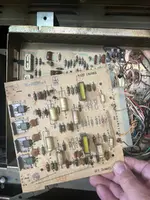
I made a harness to hold the poweramp out of the way, so I could get to the pre-amp and do some tests with the power on:
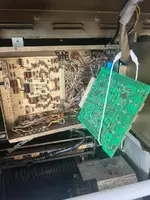
The pre-amp seems ok, it's generating both L & R output signals ok. and those signals are reaching the power amp board.
I decided to re-cap the pre-amp anyway.
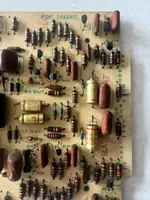
I snipped legs of some caps and tested them - they were way out of spec - they're 50 year old, so time to replace.
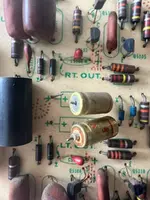
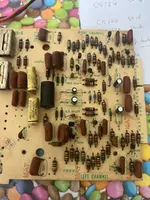
Another test and still no Left channel.
The Power amp has an edge connector (so does the pre-amp), but 4 connections are belt & braces soldered to the board as well:
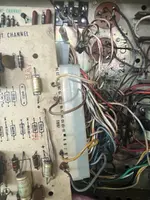
It seems that the early amps didn't have this mod and problems were reported with the power transistors blowing up. Those 4 connections are for the bias circuit and go out to a potentiometer for each channel. If the edge connector loses connectivity momentarily, there is danger of overload and blowing the output transistors. Hence the hard wired fix.
I tested the on board output stage transistors NPN and PNP for both channels. They all appear ok.
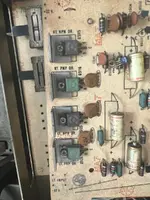
I unscrewed the heatsink to get to the final stage power transistors, and again all 4 tested out ok with a meter (not a full test as there are driven at +32 and -32v, so they could still be the problem).
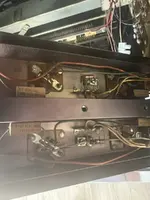
Next job is to recap the main amp board and see if that solves the issue.
If not I'll have to chase the signal through the circuit board.

I powered on and the record player mechanism sprung into life and selected a record and started playing it. I rejected it using the wired remote and the next record was selected for playing. I rejected again and it continued to select the next record. It was playing "B" sides, then when it got to & played the first record in the rack it switched to going through all the "A" sides....., then back round to the "B" sides. There is obviously a fault with the read-out from the Tormat - I'll look into that later.
I also noticed I could select as many records as I wanted, - It appears maybe to have ben modded to free-play (but not sure). The selection relay is pulled in all the time, which isn't a great idea as the coil starts to get warm/hot after 5 minutes or so. (Back in the day, a customer would enter a coin and maybe take a few minutes making their selections, then the coil would de-energize, so it was designed to hold in for at least a few minutes, but not for hours on end). This is another thing I need to take a closer look at.
The good news was I got some sound out of the speakers. On closer inspection I noticed only the Right hand channel speakers were producing any sound. There is a top tweeter horn and a bass speaker in the bottom of the cabinet. I checked the wiring of the speakers to the amplifier and all is wired correctly. I swapped the left and right speaker wires and the sound switched to the other speakers (however I noticed the left tweeter isn't working, but the bass speaker was). SO: We have an issue with the left channel amplifier and also a duff tweeter on the Left channel. I tested the tweeter resistance and it's open circuit - so will have to source a new tweeter.
On to the amplifier. It's a SHA2 Seeburg Solid State Amplifier. The amp is housed in a metal case that opens to reveal 2 circuit boards and some discreet components. On the reas are 3 transformers, a relay, 4 power transistors on a huge heatsink and all the input and output connectors.
I checked the signal from the stereo cartridge and it is outputting both Left and Right Signals OK.
The 2 boards are the pre-amp and the main power amp. The pre-amp is situated behind the power amp.

I made a harness to hold the poweramp out of the way, so I could get to the pre-amp and do some tests with the power on:

The pre-amp seems ok, it's generating both L & R output signals ok. and those signals are reaching the power amp board.
I decided to re-cap the pre-amp anyway.

I snipped legs of some caps and tested them - they were way out of spec - they're 50 year old, so time to replace.


Another test and still no Left channel.
The Power amp has an edge connector (so does the pre-amp), but 4 connections are belt & braces soldered to the board as well:

It seems that the early amps didn't have this mod and problems were reported with the power transistors blowing up. Those 4 connections are for the bias circuit and go out to a potentiometer for each channel. If the edge connector loses connectivity momentarily, there is danger of overload and blowing the output transistors. Hence the hard wired fix.
I tested the on board output stage transistors NPN and PNP for both channels. They all appear ok.

I unscrewed the heatsink to get to the final stage power transistors, and again all 4 tested out ok with a meter (not a full test as there are driven at +32 and -32v, so they could still be the problem).

Next job is to recap the main amp board and see if that solves the issue.
If not I'll have to chase the signal through the circuit board.
Attachments
Recapped the main amp board and it’s made no difference to the missing Left channel. Ive disconnected the right side temporarily so i can hear the left side. The bass speaker is humming which is a good sign, started to trace the signal through the board using:
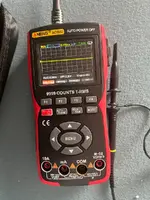
For a bit of light relief I’ve done a couple of minor jobs :
1. Cleaned the horrid label marks off the sides;
Before:
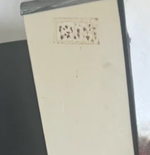
After:
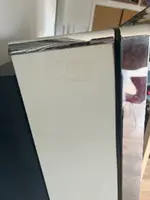
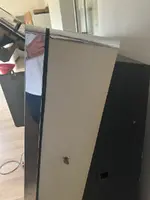
2. Replaced the coin box door lock as it had no key:
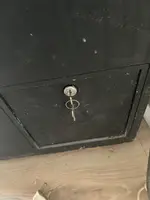
Pic of the rear amp box that I forgot to post earlier
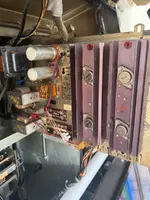

For a bit of light relief I’ve done a couple of minor jobs :
1. Cleaned the horrid label marks off the sides;
Before:

After:


2. Replaced the coin box door lock as it had no key:

Pic of the rear amp box that I forgot to post earlier

This morning has been about finding the issue in the Main Amp left channel. Whilst measuring various test points, the left channel suddenly started working. Possible explanations are "loose wire" or "loose edge connector", or "loose component" or "failed/failing component". I've already established that the audio signal is arriving into the board ok, so am ruling the first 2 out.
I inspected the rear of the board and there are no cracks or loose connections. So I'm left with the "failed/failing" component.
Here is the Left channel circuit diagram:
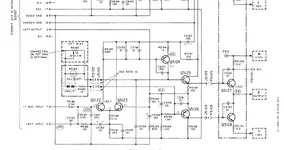
The signal comes in bottom left into a pair of transistors - these are set up as a differential amplifier, comparing the input and the output signals. - The output signal is from Q5122 straight into Q5124.
As far as I can test, Q5122 and Q5123 are working correctly and the input to Q5124 also appears correct. Q5124 is effectively a voltage gain that feeds into the driver transistors Q5125 and Q5126. The output of
Q5124 seems incorrect and I think that transistor is the issue.
I powered off and left the system for an hour. When I returned and re-powered up, the Left hand channel was missing again. I probed Q5124 with my meter and whilst doing so, the left channel came back on and stayed on whilst
I played a few records. I powered off and left it 10 mins, then back on and the left channel still working.
I switched off for an hour, then restart and then it stops working.
I'm going to replace Q5124 as it seems to be working intermittently. It seems it doesn't work when powered up from "cold" and only sparks into life when "tickled" with a bit of grounding or raising the collector voltage.
I've seen failing transistors do strange things like this, so it's my no.1. suspect.
The resistors and small caps surrounding it - test ok. But maybe I'll replace the caps.
Now got to wait for a new transistor to arrive in the post!
I inspected the rear of the board and there are no cracks or loose connections. So I'm left with the "failed/failing" component.
Here is the Left channel circuit diagram:

The signal comes in bottom left into a pair of transistors - these are set up as a differential amplifier, comparing the input and the output signals. - The output signal is from Q5122 straight into Q5124.
As far as I can test, Q5122 and Q5123 are working correctly and the input to Q5124 also appears correct. Q5124 is effectively a voltage gain that feeds into the driver transistors Q5125 and Q5126. The output of
Q5124 seems incorrect and I think that transistor is the issue.
I powered off and left the system for an hour. When I returned and re-powered up, the Left hand channel was missing again. I probed Q5124 with my meter and whilst doing so, the left channel came back on and stayed on whilst
I played a few records. I powered off and left it 10 mins, then back on and the left channel still working.
I switched off for an hour, then restart and then it stops working.
I'm going to replace Q5124 as it seems to be working intermittently. It seems it doesn't work when powered up from "cold" and only sparks into life when "tickled" with a bit of grounding or raising the collector voltage.
I've seen failing transistors do strange things like this, so it's my no.1. suspect.
The resistors and small caps surrounding it - test ok. But maybe I'll replace the caps.
Now got to wait for a new transistor to arrive in the post!
Always great when you get one of these shp amps going again. great sound out of them.
So, whilst waiting for parts, I took a look at why the machine is playing every record in sequence.
It turns out to be a surprisingly easy fix.
As the machine scans up and down the rack of records, it “reads” the corresponding memory position in the Tormat memory system. And the output of the Tormat is a single circuit that feeds into the main control centre. It’s a shielded cable and plugs into the control centre unit via an rca connector.
I cleaned the connector pin and outer earth shield and that fixed the issue. The signal wasn’t getting through properly.
Hot on the heels of that success, I then had a look at the coin credit and record selection issue. I think the credit decrease circuit wasn’t working or the credit unit was jammed - I took it out and had a play and now it’s all working perfectly. The machine is set to give 10 play credits for 50p and one credit for 10p. (Uses old large 50p and 10p).
I’ve no desire to put it on perm free play, but I may install a “credit add” button to the rear of the cab. There is a nasty chunk of wood on the back acting as a cover for the factory hole used to feed wires out to external accessories - remote volume, speakers etc. I think I’ll add a thin wooden cover with a “credit add” button installed in it. This way I am not drilling a new hole into the cabinet itself.
The credit control unit inside does have a free credit switch - but it’s a pain having to open the door to add credits.
Tomorrows job is to look at the carriage mech and make sure it’s ok, properly set up, lubricated, de-gunked etc.
It turns out to be a surprisingly easy fix.
As the machine scans up and down the rack of records, it “reads” the corresponding memory position in the Tormat memory system. And the output of the Tormat is a single circuit that feeds into the main control centre. It’s a shielded cable and plugs into the control centre unit via an rca connector.
I cleaned the connector pin and outer earth shield and that fixed the issue. The signal wasn’t getting through properly.
Hot on the heels of that success, I then had a look at the coin credit and record selection issue. I think the credit decrease circuit wasn’t working or the credit unit was jammed - I took it out and had a play and now it’s all working perfectly. The machine is set to give 10 play credits for 50p and one credit for 10p. (Uses old large 50p and 10p).
I’ve no desire to put it on perm free play, but I may install a “credit add” button to the rear of the cab. There is a nasty chunk of wood on the back acting as a cover for the factory hole used to feed wires out to external accessories - remote volume, speakers etc. I think I’ll add a thin wooden cover with a “credit add” button installed in it. This way I am not drilling a new hole into the cabinet itself.
The credit control unit inside does have a free credit switch - but it’s a pain having to open the door to add credits.
Tomorrows job is to look at the carriage mech and make sure it’s ok, properly set up, lubricated, de-gunked etc.

